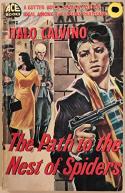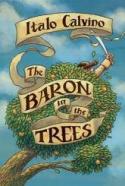An armchair psychiatrist might suggest the Italian author Italo Calvino’s career was a long and wondrous exercise in rebellion against his parents. Regarded as a master of magical realism, Calvino (1923-1985) was reared by two staunch empiricists. Both his parents were botanists who encouraged free-thinking, fiercely rejected religion and were deeply committed to seeing the world as it was.
While he admired his parents and their work in the scientific field, he was drawn towards the humanities from a young age. However, in an effort to appease his parents’ desires for him, Calvino studied agronomy at the University of Turin and then later at the University of Florence. But, secretly, Calvino dreamed of becoming a playwright, reading and writing in much of his free time.
His studies were cut short in 1943 when he went into hiding in order to avoid military service in the Italian army which was fighting alongside the Nazis. Calvino was an active member of Italy’s communist party until 1957, when evidence of Stalin’s crimes led him to leave the party while still embracing much of the ideology.
 Calvino’s early fiction was relatively realistic with political overtones. His debut novel, The Path to the Nest of Spiders (1947), is a lively coming-of-age story about an orphan who joins a group fighting the fascists during World War II. His most famous works include The Complete Cosmicomics (1965), which tells the story of the origins of the universe through the eyes of an ageless guide named Qfwfq; Invisible Cities (1972), where Marco Polo regales the aged Kublai Khan with stories of the cities he has seen in his travels around the empire: cities and memory, cities and desire, cities and designs, cities and the dead, cities and the sky, trading cities, hidden cities – fantastic places that are more than they seem; and If on a Winter’s Night a Traveler (1979), which is not one novel, but ten, each with a different plot, style, ambience, and author, and each interrupted at a moment of suspense. Together they form a labyrinth of literatures, known and unknown, alive and extinct, through which two readers, a male and a female, pursue both the story lines that intrigue them and one another.
Calvino’s early fiction was relatively realistic with political overtones. His debut novel, The Path to the Nest of Spiders (1947), is a lively coming-of-age story about an orphan who joins a group fighting the fascists during World War II. His most famous works include The Complete Cosmicomics (1965), which tells the story of the origins of the universe through the eyes of an ageless guide named Qfwfq; Invisible Cities (1972), where Marco Polo regales the aged Kublai Khan with stories of the cities he has seen in his travels around the empire: cities and memory, cities and desire, cities and designs, cities and the dead, cities and the sky, trading cities, hidden cities – fantastic places that are more than they seem; and If on a Winter’s Night a Traveler (1979), which is not one novel, but ten, each with a different plot, style, ambience, and author, and each interrupted at a moment of suspense. Together they form a labyrinth of literatures, known and unknown, alive and extinct, through which two readers, a male and a female, pursue both the story lines that intrigue them and one another.
Describing his writing, Calvino provided one the greatest articulations of why authors create books: "I began doing what came most naturally to me – that is, following the memory of the things I had loved best since boyhood. Instead of making myself write the book I ought to write, the novel that was expected of me, I conjured up the book I myself would have liked to read, the sort by an unknown writer, from another age and another country, discovered in an attic."
 His genius for persuading readers to suspend their disbelief and surrender to his magical realms has influenced generations of writers. One of them is Daniel Wallace, whose imaginative tales include Big Fish: A Novel of Mythic Proportions (1998), Ray in Reverse (2000), and Extraordinary Adventures (2017). We are grateful to him for writing this appreciation of Calvino’s 1957 novel, The Baron in the Trees.
His genius for persuading readers to suspend their disbelief and surrender to his magical realms has influenced generations of writers. One of them is Daniel Wallace, whose imaginative tales include Big Fish: A Novel of Mythic Proportions (1998), Ray in Reverse (2000), and Extraordinary Adventures (2017). We are grateful to him for writing this appreciation of Calvino’s 1957 novel, The Baron in the Trees.
Appreciation of Italo Calvino’s The Baron in the Trees by Daniel Wallace
“The Baron in the Trees” is the novel I think of as a singular and instrumental influence on me and my life as a writer. That being said, I read it decades ago I remember very little of it now: characters, plot points, major themes or motifs. Not really sure about those things. I do remember a dog, a woman, Voltaire . . . In a nutshell: in 1767 a strong-willed 12-year-old son of an Italian baron refuses to eat snails one night, is sent from the table, climbs an oak and swears never to come down – and doesn’t, not for the entirety of the novel. The rest of his life is lived in the trees. Which is impossible, but I believed every word of it.
 In fact, other than this one detail (that our main character traverses Europe, has friends and lovers and a dog without ever touching toe to ground) the story is told in the most realistic and historical detail.
In fact, other than this one detail (that our main character traverses Europe, has friends and lovers and a dog without ever touching toe to ground) the story is told in the most realistic and historical detail.
That is the great lesson I took from this book and from Calvino’s other books as well: that as long as the reader feels secure in the hands of an honest, forthright storyteller the writer can get on with the business of adornment and exaggeration, the making up of things that never happened, never could have happened, and never will, and the reader will believe that too. It’s called magical realism, but it might just as well be called realistic magic.